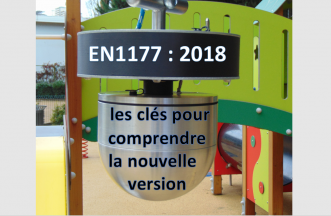
Contrôle des sols d’aires de jeux : les clés pour comprendre la version 2018 de la norme EN1177
par Flavien Bérut

Did you miss our interlaboratory testing webinars? Don’t panic, we’ll explain everything to you in this article! Our Satis Métrologie brand is launching a new service: interlaboratory comparisons, also called “round robin” or “aptitude tests”.

Normenjeu and Satis métrologie organize HIC & gmax interlaboratory testing
What is it about ? A measurement or test carried out under the same conditions, by different laboratories. We then compare the results of each participant to verify whether or not they find the same resuklts. These results are then comlpare to the ones they should have found. A score is then assigned to each laboratory according to the results found. Rating assigned by the organizer, ie Satis Métrologie. These tests are used to validate test methods and results uncertainty.
What about HIC tests, which calculate the critical fall height for surfacing in playgrounds and sports equipment? “For HIC tests, there is no such thing as an international standard,” explains Flavien Bérut, business manager and R&D supervisor.
To carry out these tests, a specific sample is sent to all participating laboratories. Based on the results they find, a robust average will be calculated, after removing outliers (those that are very far from expected results). It is this average that will serve as a reference thereafter. Each laboratory will then be assigned a score according to the result found. The closer the latter is to the robust average, the better the score.
These tests also make possible to determine measurement uncertainties, using the Z-score. Usually, a Z-score of less than 2 is acceptable. Beyond 3, it is indicative of an anomaly. “In the field of HIC tests, we must aim for a Z-score of less than 1, given the diversity of surfacing and materials,” explains Flavien Bérut.
In this case, the laboratory must take corrective actions. But what can be the causes of a bad Z-score? According to Ishikawa’s 5Ms, we generally identify five areas that can be incriminated: method, man (workforce), machine (test device), material and medium (environment of the measurement) .
However, for interlaboratory comparisons in the field of HIC tests, the material cannot be the cause of the problem (all the participants have the same sample), nor the environment (the tests are carried out in the laboratory under controlled conditions and not on site). As a result, the error can only come from the method, the man or the machine. To determine which of those 3 “M” is involved, it is then necessary to carry out an R&R study (repeatability & reproducibility).
Participating in the interlaboratory tests organized by Satis Métrologie has several advantages:
The registration campaign is launched. If you have not yet received a registration form, contact us by email: info@normenjeu.fr
Recommandation